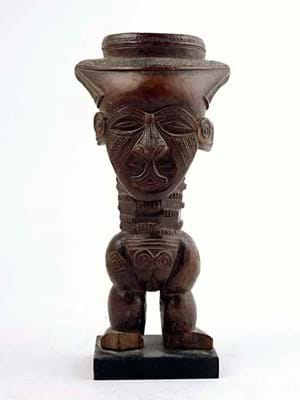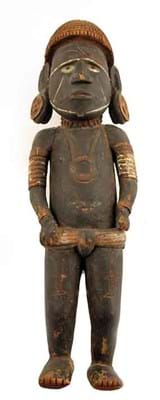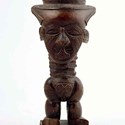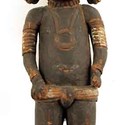The items from his estate which dominated the January 8 sale at Woolley & Wallis of Salisbury - a £410,000 event described by auctioneer Will Hobbs as their best-ever traditional year-opener - of course featured much of the tribal art with which the family name is almost synonymous.
Not only did it sell very well, it underlined the prospects for British auctioneers in a specialist field which has largely been left to Paris and New York in recent years.
As ATG readers will have seen, tribal art has made a number of very successful appearances at provincial sales in recent years and, at Salisbury, Mr Hobbs said: "I've been trying to develop tribal art for some time and build a reputation. A sale such as this obviously helps."
Ernest Ohly inherited the Berkeley Gallery in Mayfair from his famous father, William. Although he closed it in 1977 he continued to be an active collector/dealer.
On his death three years ago, Christie's took the prize piece of the collection, the so-called Ohly figure, an 8ft (2.44m) tall, carved wood figure from Central Polynesia which took a premium-inclusive €961,000 in Paris in June 2011.
Such stratospheric heights, however, remain the preserve of Paris and New York rather than the UK.
Overseas Interest
"Christie's and Sotheby's used to include tribal sales in London," said Mr Hobbs. "But sometime in the '90s they took the decision to hold high-end tribal auctions in Paris or New York.
London fell behind, to the chagrin of specialist dealers such as Clive Loveless who says: "In Britain we're just waking up again to tribal art. We've been rather asleep for the past few years. I don't think the British Museum closing their separate Museum of Mankind in Burlington Gardens after 30 years and moving the ethnography back to the main Bloomsbury building in 1997 helped.
"The major collectors are in America, France and Belgium, which is why Sotheby's and Christie's hold their top sales there. But interest is growing here with new collectors coming into the market.
"There is a range of good material to be had for three figures and although a rare figurative piece will sell at £5000-7000, that's still reasonable for a beautiful piece of art."
Both he and Mr Hobbs agree that online catalogues and bidding are a major new force, providing access to world markets for regional salerooms that wish to move into specialist areas.
Certainly this was a factor at the Salisbury sale. There was also considerable interest in the room but almost all the top lots went to European or American dealers or collectors.
Of the 113 lots of tribal art, 36 were provenanced to Ernest Ohly, accounting for £111,400 of the section's £123,500 total. Both African and Oceanic art featured among the higher prices.
Yaure Mask
Topping the day was the Yaure mask from the Ivory Coast. The 15in (38cm) tall mask with ribbed horns and white pigment, and pierced and pointed beard, carried the section's highest estimate of £4000-6000 and sold at £17,000.
An example of the much-prized work of the Kuba people of the Central Congo was a 10in (25cm) high anthropomorphic cup with a shaped coiffure and an interlaced line and dash motif. The toes were missing but the £800-1200 estimate was, as with all the Ohly pieces, of a here-to-sell variety, and it duly sold at £12,000.
Also keenly sought are the carvings of the Fang people who now occupy areas of Cameroon, Equatorial Guinea and Gabon.
Here a 12in (30.5cm) high female figure, with her hands over her abdomen, with a red pigment and ebonised coiffure, made a 20-times estimate £6500.
Other African material to eclipse estimates included a Luba (Katanga) 5ft (1.53m) long staff of office, with a Janus head finial and panel carving at £5800; an Ovimbundu (Angola) wood and metal pipe, of a 21in (53cm) long standing figure with a bead necklace at £5200 and a 19th century Baule (Ivory Coast) 9in (23cm) high beauty mask, with a triple crest coiffure and the remains of three horns at £5500.
Although Mr Ohly's African pieces dominated the higher prices, Oceanic art was well represented by a 22½in (57cm) high, carved wood standing male figure from the Solomon Islands.
Dated to the early 20th century, the ebonised figure with white and red pigments sported a hat, inset shell eyes, a circular chest pendant, a shaped pendant to his back and shark 'tattoos' on his legs.
Estimated at £300-400, it sold at £11,000.
Native American
Also performing well were two of Ohly's tribal pieces related to North America.
A Woodland Indian war club of gunstock form, 2ft 3in (68cm) long, was worked with ebonised dog-tooth notches to one side and four incised figures to the other. These 'war records', denoting the number of kills by the owner are desirable additions and this example was further inscribed in ink War Club belonging to the Chief of the W. Rice Indians / with Fitz's...
Pitched at £2000-3000, it sold at £5200.
But less of a known quantity was a 9¾in (25cm) high carved wood oval mask with a dark green patina. Catalogued as 'possibly Alaskan', it was estimated at
£200-300 but sold at £4300.
As in any strong market, tribal art is bringing concerns about fakes, or perhaps more fairly in this field, the modern craftwork on traditional lines produced for the tourist trade. It is known to some by the somewhat disparaging term 'airport art'.
So while there may occasionally be boot-sale bargains to be had, what buyers look for are a good provenance and the expertise of a specialist.
But even when both are very much in evidence, as with the Ernest Ohly pieces at Woolley & Wallis, there can be marked differences in prices. A case in fact were two female figure carvings at the sale which were both made by Yoruba (South West Nigeria and Benin) craftsmen and both were estimated at £300-400.
One was a 13½in (34cm) high kneeling figure with beads and offering bowl and a child on her back came with a stockbook note Ayasse, Ilorin[Nigeria]confiscated by E.C. Pickwood, 1922. It made £500.
The other was a 16½in (42cm) high mother and child group with red and ebonised staining which sold at £6200.












